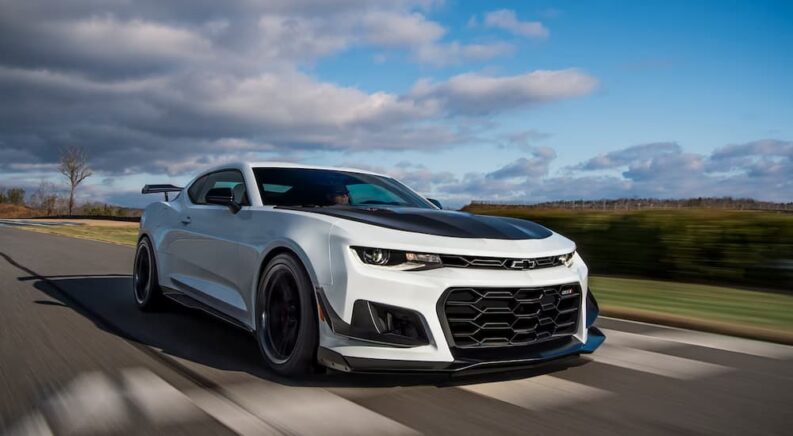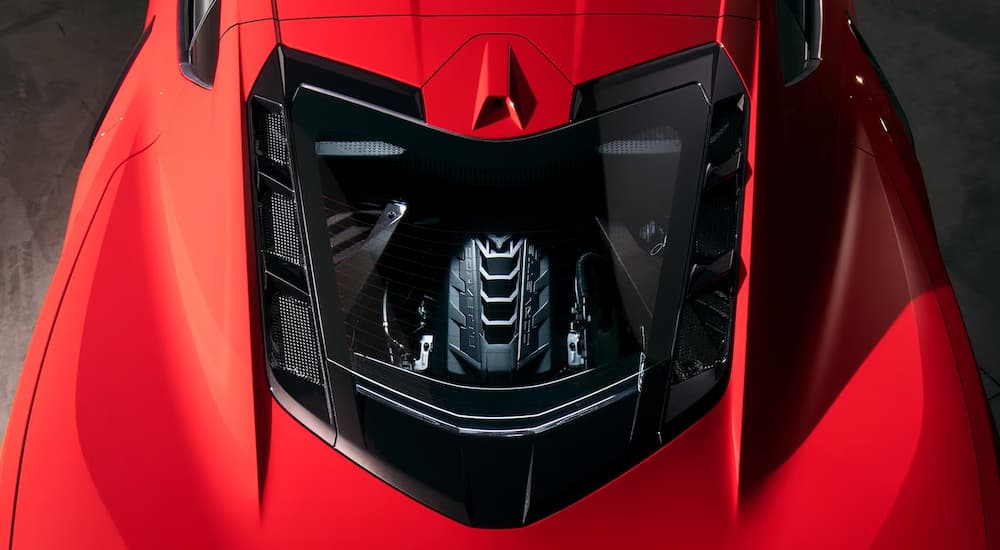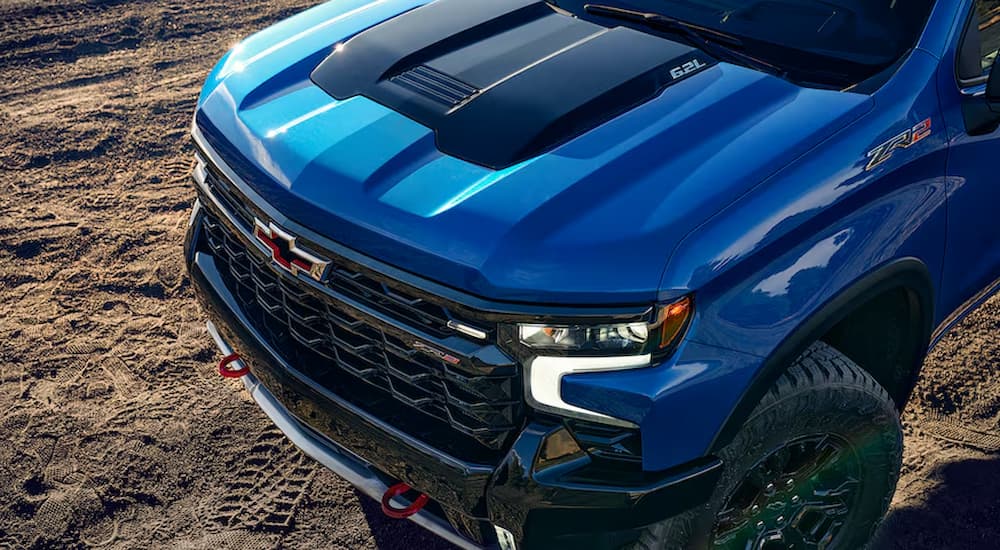Whether you’re talking about the Camaro, Corvette, or award-winning pickups like the Silverado and Colorado, the name “Chevy” has long been synonymous with performance. Walk into your local Chevy dealer and you’ll find exciting new models like the 2024 Camaro, a potent pony car powered by a small-block V8 that puts out 455 hp and 455 lb-ft of torque.
This is just the latest example of the type of unhinged automotive creations the bowtie brand has been crafting for over a century, but if you want to really test the limits of your Chevy’s power, you might have to take matters into your own hands. That’s where Chevrolet Performance comes in. This in-house automotive performance parts brand is here to help drivers take their Chevy vehicle to the next level with a full catalog of performance-related accessories for every corner of their car.
The 2024 Camaro is already pretty thrilling right out of the box, but just imagine what sort of high-speed hijinks you could get up to with the addition of an axle-back exhaust, short-throw shifter, lowered suspension, or six-piston Brembo front brakes.
These are just a few offerings that can be found on the pages of the Chevrolet Performance catalog (or the brand’s website), but what exactly is Chevrolet Performance, how did it start, and why should a driver buy direct from Chevy when there are so many companies already producing aftermarket components for a wide range of vehicles? Let’s discuss…
A Legacy of Performance
Originally established in 1967 to support the automaker’s Trans-Am Camaro racing teams, Chevrolet Performance (then known as GM Performance Parts) was soon expanded to the public in order to give all drivers the opportunity to upgrade their own vehicles with some of the industry’s finest components. It was a logical step for the automaker, allowing GM to capitalize on the considerable success of the third-generation Corvette and its new ZL1 engine.
Based on the popular 427 Mark IV V8, the ZL1 would come to revolutionize the aftermarket scene and create a whole new sales channel in the process. The ZL1 was packed with a long list of heavy-duty components that wouldn’t be out of place at a NASCAR paddock, including parts specifically designed to increase horsepower and reliability under high RPMs.
The buzz around the souped-up 427 small-block engine would lead Chevy to revolutionize the aftermarket parts industry with the introduction of the industry’s first crate engine. This direct-to-consumer approach saw engines like the ZL1 shipped to customers in a wooden shipping crate, giving drivers the chance to drop a world-class powerplant in their project car or any compatible GM model. These crate engines were typically pretty bare bones, requiring drivers to invest in auxiliary components like fuel injection systems and intake manifolds, but for the right sort of DIYer, they opened the door to a whole new world of high-performance possibilities.
Chevy’s presence in the auto racing scene would play a big part in the growth of GM Performance Parts. The GM Performance Parts logo would become a mainstay on some of the winningest NASCAR models of the ’70s and ’80s, from three-time champ Cale Yarborough’s #11 Chevy to Dale Earnhardt’s Winston Cup-winning #3. The company’s 18-wheeler was a regular fixture at auto races and car shows throughout the ’80s, allowing customers to shop for parts and pick the brains of brand reps. GM Performance Parts would continue to increase its marketing presence, including sponsorship for NHRA Drag Racing standout Warren Johnson, but it was the 1989 introduction of a standalone catalog that would really bring the brand to the masses.
GM Performance Parts became Chevrolet Performance in 2012, expanding its focus beyond parts and sponsorships to design new performance-focused variants of current production models. The first—the Camaro ZL1—would serve as a fitting proof of concept, churning out 580 hp and 556 lb-ft of torque to become the most powerful production Camaro ever produced. Chevy would introduce the limited-edition COPO Camaro later that same year, packing the fifth-gen model with a 427 engine (or two supercharged 327 options) and a two-speed PowerGlide automatic transmission.
Chevy Performance has continued to churn out hits over the last decade, with notable models including the 2019 ZR1 Corvette. As the fastest Corvette ever made, this model certainly garnered a lot of attention on its debut thanks to its blistering 217-mph top speed—but few drivers realize just how much influence Chevy Performance had when it came to that supercharged, 755-hp beast.
The Catalog of Dreams
The current Chevrolet Performance catalog is a one-stop shop for your wildest automotive ambitions. Crate engines still represent a sizable chunk of the company’s business, but they’re not all created equal. Chevy currently offers almost sixty different crate engines and four different levels of assembly.
Those seeking a real, built-from-scratch experience can opt for a Partial engine, which includes the block, reciprocating assembly, and little else. A Base engine comes with the block, crank, pistons, cam, heads, and valve covers but gives drivers the chance to choose their carburetor/injector system and intake manifold. The Deluxe offering is practically ready to go right out of the box with the distributor and harmonic balancer already bolted on; simply install the included carburetor and you’re ready to put the engine through its paces. Lastly, there’s the Turn-Key option: these crate engines have been thoroughly built out by Chevy engineers, meaning you’ll enjoy consistent, reliable power with minimal hassle and setup.
Popular crate engines include the L8T, a 6.6-liter beast designed specifically for competitive use. As the largest displacement engine in Chevy’s LT lineup, the L8T was originally designed for the Chevy Silverado 2500 HD and 3500 HD. When jammed into the hood of your hot rod or project car, this 401-hp engine can turn any ride into a no-holds-barred performance model. GM has experimented with this engine in the Cadillac CTS-V development car, infusing that luxury model with all the benefits of direct fuel injection, a forged steel crankshaft, and a 10.8:1 compression ratio.
Crate engines might be Chevrolet Performance’s bread and butter, though they’re far from the only high-performance parts on offer. Chevrolet Performance also specializes in transmissions, individual engine components like blocks, camshafts, cylinder heads, and fuel pumps, and ready-made Connect & Cruise powertrain packages complete with engines, transmission, controllers, and harnesses.
Are you looking for aero, exhaust, brake, interior, and suspension upgrades specific to your make and model? Chevrolet Performance’s website makes it easy to search for performance parts for the fifth- and sixth-gen Camaro, 2014-2019 Corvette, Silverado, and Colorado. The truck-specific upgrades can help turn a stock Chevy pickup into a dedicated off-roader with the addition of a two-inch suspension lift kit, leaf springs, or jounce shock system.
From spoilers and exhaust tips to cold-air intakes, leveling kits, and more, any gearhead is bound to get lost in the pages of Chevrolet Performance’s catalog or website.
Why Go With OEM?
So why should a driver choose OEM parts from Chevrolet Performance when they’re looking to elevate their ride? There is certainly no shortage of retailers, both internet-based and brick-and-mortar, who would be more than happy to help you outfit your vehicle with a factory’s worth of performance parts, tech upgrades, and other accessories, but it all comes down to reputation.
Simply put, original equipment manufacturer (OEM) parts are generally held to a higher standard than the competition, which are commonly known as aftermarket parts. Chevrolet Performance’s OEM parts are produced by the same company that was responsible for building your Chevy vehicle itself, which confers all sorts of advantages for reliability, performance, and even cost.
The last might be a little hard to believe as consumers tend to think of aftermarket parts as being a less expensive alternative to OEM offerings, but it’s a matter of simple math. OEM parts are engineered to a higher standard, meaning they’re less likely to fail and require an expensive replacement. You might save a few bucks initially by going with an aftermarket clutch kit, but if it fails prematurely, it’ll suddenly start looking like much less of a deal.
This gulf in quality might not matter so much when you’re talking about accessories like a tonneau cover, seat cover, or cargo rack, but that same logic doesn’t hold true when you’re dealing with the transmission, engine, and other vital performance-related components. If one of these components were to break down at the wrong time, the downstream effects could be significant and result in a hefty repair bill.
While there’s no guarantee that a Chevrolet Performance part won’t also fail under extreme conditions, one must also factor in the difference in warranty coverage. All of Chevrolet Performance’s OEM parts come with a Limited Parts Warranty that’ll protect drivers in case of a malfunction. The warranties offered with aftermarket parts (if there even is one) tend to be a little less comprehensive. It’s one of the main reasons aftermarket parts are often cheaper than their OEM counterparts and a perfect example of why the price shouldn’t be the only factor you consider when you’re in the market for an upgrade. Using aftermarket parts on a Chevy vehicle that’s still covered by the original factory warranty can also jeopardize your coverage should something go wrong.
Finally, there’s the issue of fit. In order to turn a profit, aftermarket manufacturers often choose to produce components designed to fit a range of different makes and models. This lack of specificity might make sense from a business perspective, as it increases the potential customer base for any specific part, but it can result in some real headaches when it comes to finding the perfect fit. Chevrolet Performance parts, on the other hand, are made with a specific vehicle in mind and are designed to meet each model’s exact specifications.
Being able to choose a part designed specifically for your vehicle also means less time spent running back and forth to the auto parts store or dealing with internet returns. The aftermarket scene can be overwhelming (and even designed to confuse or upsell customers), but you won’t have to worry about any such issues when you stick with Chevrolet Performance parts.
Chevy OEM Performance Parts
For over fifty years, Chevrolet Performance has been helping drivers push their vehicles to the limit. From crate engines and race-tuned suspensions to spoilers and even exhaust upgrades that can help add a little extra horsepower to the mix, the parts, components, and accessories found in the pages of the Chevrolet Performance catalog have inspired their fair share of automotive daydreams.
While this company obviously emphasizes performance, its catalog is also home to a number of appearance-related upgrades that can go a long way toward helping you set your Chevy or project car apart from the crowd. Engine covers can provide an eye-catching pop of color under the hood, while carbon-fiber aero elements can improve both the look and performance of Chevy’s sportier offerings. Best of all, the Chevrolet Performance catalog allows drivers to invest in their vehicle with confidence using OEM parts designed to stand the test of time.
Whether you’re looking to build a new, track-ready rig from the ground up or just looking to refresh your trusted Camaro, Corvette, or Chevy pickup, Chevrolet Performance is there to help.






